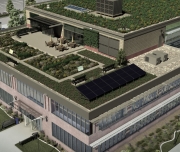Integrative Design Process
The integrative design process understands that buildings, their components, their use and their place and surroundings are interrelated. Whole building systems observe this principle by involving all stakeholders from project conception through delivery and beyond. Engaging all stakeholders in the design process to create a cross-disciplinary team and using a systems thinking approach helps to identify synergies and benefits that might otherwise go unnoticed, resulting in reduced initial and operating costs and optimizing performance. Planted roof considerations include energy efficiency, stormwater management, biodiversity, and urban heat islands. The performance of a planted roof is optimized when coordinated with other building systems, including HVAC and Water. A planted roof has insulating benefits that may reduce the building’s heating and cooling loads. Non-potable water may be considered for planted roofs and landscaping.
The integrative design process brings key players to the table to consider and integrate the planted roof with the architecture and other systems of the building. Roles and responsibilities should be clearly defined and based on the common objective to balance high performance with low operating costs. Stakeholders can leverage the planted roof to add value to the building while also providing benefits to the site and community.
Owner
The Owner’s Project Requirements (OPR) establish prioritization of critical design and operational criteria. The owner determines the project scope and budget, takes over on-going maintenance at project completion, and wants to maximize the project’s return on investment as well as the building’s market value. A planted roof can add to a building’s property value as an amenity that benefits occupants while lasting longer than conventional roofs and reducing energy and stormwater management costs.

Architect
The architect leads the planted roof design team, coordinating closely with the civil engineer, structural engineer and planted roof consultant to design the roofing system with overall building performance goals and properties in mind.

Planted Roof Professional
The planted roof professional (or green roof professional) is responsible for the design, layout, growing medium and plant selection for the planted roof and can offer unique insights into the best practices for optimizing planted roof benefits according to project goals. The planted roof professional coordinates closely with the architect, civil engineer, structural engineer, facility manager and operations and maintenance personnel on all aspects of the planted roof design, installation and maintenance activities and provides quality control.

Structural Engineer
The structural engineer determines structural loads associated with the planted roof and ensures that the structure is safe for installation. The structural engineer’s top priority is the structural stability of the overall building and must consider all future roof applications, including plant growth, in their analysis.

Civil Engineer
The civil engineer determines the drainage capacity of the roof and its impact on stormwater and coordinates closely with the architect and planted roof professional to determine planted roof design alternatives that minimize stormwater runoff and improve drainage systems.

Mechanical Engineer
The mechanical engineer is responsible for sizing the heating and cooling equipment based on both internal heat loads and heat loss through the building envelope, which may be facilitated by energy modeling. The size and type of planted roof impact the size of HVAC systems and its characteristics can help reduce cooling loads.

Landscape Architect
The landscape architect is responsible for site analysis and sustainable landscape design and should consult with the planted roof professional about the design, layout, plant, and growing medium selection for the planted roof.

Roofing or Waterproofing Consultant
The roofing or waterproofing consultant determines the best waterproofing system and strategy for the design of the planted roof and should be brought into the integrative design process early to ensure the integrity of the roofing system.

Operations and Maintenance Personnel
Operations and maintenance personnel, in close coordination with the facility manager, are responsible for the maintenance and performance of the building envelope and landscape areas, including the planted roof. The facility manager and operations and maintenance personnel should coordinate with the planted roof professional on proper maintenance activities.

Facility Manager
The facility manager, in close coordination with operations and maintenance personnel, is responsible for the maintenance and performance of the building envelope and landscape areas, including the planted roof. The facility manager and operations and maintenance personnel should coordinate with the planted roof professional on proper maintenance activities.


